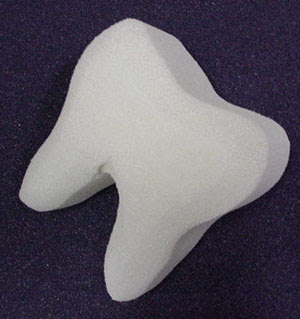 Hemangioma is a soft tissue tumor that often occurs in newborns and in children younger than 1 year (5-10%). Typically, hemangiomas have appeared since the baby was born (30%) or appear after a few weeks after birth (70%). Hemangiomas appear at any place on the surface of the body, such as head, neck, face, legs or chest. Do not be afraid, most hemangiomas are not dangerous because most cases of hemangiomas may disappear by itself a few months after birth. Be wary if the hemangioma is located in a vital part of the body, such as the eyes or mouth. This is because, when it covered most of the places that will disrupt the process of eating and sight, or if the hemangioma occurs in internal organs (gut, respiratory organ, the brain) may interfere with the process of working these organs.
Hemangioma is a soft tissue tumor that often occurs in newborns and in children younger than 1 year (5-10%). Typically, hemangiomas have appeared since the baby was born (30%) or appear after a few weeks after birth (70%). Hemangiomas appear at any place on the surface of the body, such as head, neck, face, legs or chest. Do not be afraid, most hemangiomas are not dangerous because most cases of hemangiomas may disappear by itself a few months after birth. Be wary if the hemangioma is located in a vital part of the body, such as the eyes or mouth. This is because, when it covered most of the places that will disrupt the process of eating and sight, or if the hemangioma occurs in internal organs (gut, respiratory organ, the brain) may interfere with the process of working these organs. Hemangioma ......... how come?
Hemangioma is due to proliferation (excessive growth) of abnormal blood vessels, and can occur in every tissue of blood vessels. Hemangiomas are benign tumors, including many found in infants and children. Until now what the cause is still unclear, but is expected to relate to the mechanisms of control of blood vessel growth.
Form Hemangioma and location:
- Capillary hemangioma (superficial hemangioma), occurs in the upper skin. Capillary hemangioma is also called Strawberry Hemangioma (hemangioma simplex), occurs at birth or a few days after birth. Common in premature babies and usually disappears a few days or weeks later. Symptoms: red spots that appear gradually bigger. Over time the color becomes bright red, demarcated and hard when touched.
- Hemangioma cavernosum, occurred at deeper skin that is in the dermis and subcutaneous (layer of the skin). In some cases, both types of hemangioma can occur simultaneously and called Hemangioma mixture. Hemangioma cavernosum usually have well defined, a purplish red bumps. When pressed deflated and inflated again when released. The disorder is composed of elements of vascular (blood vessel) are mature, and there is the deep layers of muscle tissue or organs.
- Mixed hemangiomas are found in the inferior extremities (lower body motion of the tool, for example, feet, thighs, etc.), unilateral (one side of the body, eg thighs left / right), solitary (single) and present at birth or in childhood -children. Characteristics; bulge is soft and bluish red color which is located in the superficial (surface) in or on the internal organs.
A. Conservative way
 Will have an enlarged hemangioma in the first months and then reached a maximum magnification, after which regresses spontaneously around the age of 1 year and continue until the age of 5 years. For Capillary hemangioma (Strawberry Hemangioma), are often not treated as hemangioma this type will be lost if left to itself and the skin looks normal.
Will have an enlarged hemangioma in the first months and then reached a maximum magnification, after which regresses spontaneously around the age of 1 year and continue until the age of 5 years. For Capillary hemangioma (Strawberry Hemangioma), are often not treated as hemangioma this type will be lost if left to itself and the skin looks normal. 2. On the way
Performed on a hemangioma that grows on vital organs such as the: eyes, ears, throat, which was bleeding hemangioma, hemangioma in the infection, hemangioma is experiencing rapid growth and cause deformity (abnormal) tissue.
3. Surgery
Performed on the hemangioma with excessively rapid growth, hemangiomas that do not shrink after 6-7 years, or hemangioma located on the face, neck, hands that grow rapidly so it is necessary to control local excision.
4 Radiation
This treatment is not done anymore because the irradiation resulted in less good for children who are still very active bone growth, as well as the complications are caused when radiation is carried out for long periods of time.
5. Sclerotic drugs
Performed on the lesion (abnormality) hemangioma. This method is often preferred because of pain and cause sikatrik (scar tissue).


-dalam.jpg)








